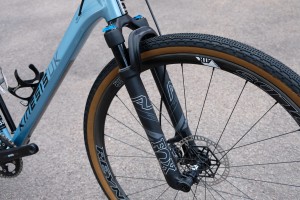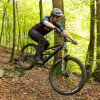When it launched in 2020, the RockShox ZEB was the first fork to pack fat stanchions that mimicked those of downhill forks. In the 2023 guise, the ZEB Ultimate brings the very latest technologies in the hope of challenging the top runners in the best mountain bike fork space. Even though a few of its features fly under the radar, its blend of stiffness and damping will please even the heaviest of enduro riders. However, a retune will massively open up this fork’s opportunity for adjustment.
- How to set up your mountain bike suspension - suspension set-up explained
- 9 tips to keep your suspension running sweeter for longer
- Air vs coil suspension - which is best for mountain biking?
RockShox ZEB Ultimate fork - Technical details
RockShox’s ZEB is an enduro-focused fork defined by its 38mm chassis which focuses on stiffness. And that’s hugely important for a long-travel fork as with more travel comes more flex, thus any extra stiffness is invaluable.
Although stiffness is the main feature of the ZEB, it also gets the very latest Charger 3 damper. This damper benefits from an all-new IFP (Internal Floating Piston) that results in more consistency as the fork moves through its travel. It also gets high- and low-speed compression adjustments that eradicate any influence each adjustment has on one another while turning those dials. This has been achieved through a fancy valving design that completely separates each adjustment’s oil flow network. There’s also a single low-speed rebound adjustment.
Featuring an all-new design, the damper gets a coil spring that sits opposite the piston. This spring is also responsible for its greater consistency throughout the fork’s travel.
At the other side of the fork is the DebonAir+ air spring that gets an increased air volume for better small-bump sensitivity and mid-stroke support and encourages the fork to stay propped up in the travel in order to raise the ride height and make for more confidence when things get steep. That air piston is now made of aluminium and a larger negative air chamber and its spring curve has been refined to pull off the desired ride character.
Along with the Ultimate Bushing Package that brings greater bushing overlap, which has been included to further boost smoothness by reducing friction, there’s RockShox’s ButterCups technology. It’s an idea that was inspired by vibration reduction systems found in chainsaws and off-road vehicles that are built to limit high-frequency vibrations that are transferred to your hands.
Telescopic suspension forks suffer from one main issue: stiction – and, often, low-level, high-frequency bumps don’t influence the fork enough to overcome stiction and break into its travel. This can result in a harsh feel that’ll lead to arm pump later into a descent and that’s where ButterCups come into play. A single ButterCup is a small container that houses two rubber pucks that compress against a metal plate, allowing for some movement internally over very small bumps. There are two at the very bottom of each fork leg with one tuned to handle the compression stroke and the other the rebound. RockShox says that this tech adds around four millimetres of vertical compliance, reducing the effect of trail chatter transmitted to the hands by 20 per cent.
Rounding off the feature list is that the ZEB runs on Maxima Plush Dynamic suspension bath oil, it’s complete with a three-bolt integrated mudguard and it’s tested to exceed e-MTB standards. There’s also a pair of torque cap adaptors in the box for use with standard hub end caps. The fork gets negative pressure release valves found at the rear of the lowers and a specific mudguard.
The ZEB Ultimate comes with travel from 150mm up to 190mm, with 38mm to 51mm offsets, and in models to accommodate 650b or 29-inch wheels. It can also work with rotors up to 220mm in size but a 200mm rotor is the smallest it can fit.
On test, we’ve got the ZEB Ultimate with 160mm of travel for a 29-inch wheel.
RockShox ZEB Ultimate - Setup
RockShox does an awful lot to make the ZEB Ultimate easy to set up. To start, there’s the brand’s Trailhead setup guide that offers sag, rebound, and compression suggestions that reliably result in a great base setup. But even without going to Trailhead, the brand has clearly marked the high and low-speed rebound dials with increments that line up with markings found on the crown. While a small, easily achieved benefit, it’s one that makes me wonder why this is so rare to find on any modern suspension fork as it’s so useful.
These little lines completely eliminate the chances of getting lost in those dials when making adjustments which is a godsend for riders of all experiences.
The rebound dial doesn’t get intricate markings, only one on the knob to denote its rotation. But it gets 18 clicks to turn through and, unlike other RockShox forks, there’s no sag guide anodised onto the stanchions. While handy, this is certainly no deal breaker.
Setting up the ZEB was quite an interesting journey as the range of adjustments available seems to suit the heavier rider. I weigh around 90kg with riding gear, which is by no means light and I’m running the fork with no Bottomless Tokens, with the high-speed compression wide open and a click or two of low-speed compression. Compared to a Fox 38 Performance, the ZEB’s range of low-speed rebound damping is certainly on the slower side, where I’m running four clicks of damping on the ZEB, and 15 on Fox’s GRIP damper to achieve a similar rebound speed. Faster and lighter riders will definitely benefit from a retune, which is often included with a full service.
Due to the larger air chamber and RockShox’s other tweaks to the air side of the fork, the ZEB Ultimate is one progressive number and that comes with upsides and downsides. The good news is that the brand has achieved its goal of offering a fork that sits higher in its travel, which I’ll get onto a little later but the bad is that it’s very frugal with the latter parts of its travel. Usually, I would run a single bottomless token or volume spacer but I’ve run this fork completely void of spacers, and even during more rigorous bike park days, I’ve struggled to reach full travel.
Thankfully, there are a number of aftermarket parts that can make an air fork more linear, such as Vorsprung’s Secus and the TruTune MTB Air Fork Insert.
Each of the ZEB’s adjusters offers a tactile and purposeful feel when pushing the dials from click to click thanks to both knurled edges and strong indexing. Every turn of a dial makes a clear and viable difference too. When combined with the index marks on the dials, this fork is a pleasure to fettle with. A clear bonus of this fork compared to those of other brands is that the volume spacers are accessed by removing a top cap with a cassette tool which is much more readily available than an unchamfered socket.
RockShox ZEB Ultimate fork - Performance
Although the ZEB can be a little funky to set up, it’s a fork that properly puts its money where its mouth is as on the trail; it’s quite a bit of kit.
The ZEB’s slightly oversized chassis ups the stiffness compared to its 36mm sanctioned counterparts significantly. Not only does this help keep the front wheel on line but its ability to so do ups confidence. So much so, that it’s given my bike a somewhat point-and-shoot mentality where I can direct it towards a techy section and be fully confident that my front wheel isn’t going to be pinged offline by an errant rock. Though, stiffness is on par with other forks kitted with 38mm stanchions.
The way in which this fork delivers and damps its travel is pretty impressive. The start of the stroke is supple as it soaks up small bumps and staves off arm pump. There’s very little stiction and little force is required for the fork to initiate its stroke. This is where the ButterCups state their case but, in reality, they work more in the background, offering a subtle level of vibration damping if any at all. And, when compared to forks that don’t run tech like ButterCups, the effect is minimal. However, during longer periods of descending, with the fork set up properly, I’ve never felt any arm discomfort.
As the fork moves deeper into its travel, it meets a heft of mid-stroke support that comes as a result of RockShox’s air-spring refinements. Even without low-speed compression damping, this extra support keeps the front of the bike nicely propped up. Though, when things begin to get a little steeper, I have found a click or two of low-speed rebound damping handy, in order to further keep the front end high in its travel.
While this level of support is definitely super helpful, it comes as a result of that more progressive air spring. That’s no bad thing but I’ve found that it’s a tough fork to push to its end stroke or bottom out. So there’s about 10-15mm of travel that’s not as freely available. However, it does mean that there’s always some travel left for when things get super gnarly, allowing for extra forgiveness should something go very wrong. But what’s very surprising is that I’m running around 10psi less than I would on any other fork and full travel is still hard to come by.
Progression qualms aside, the ZEB is a great performing fork with a smooth and almost frictionless delivery of its travel. Its chassis is great, too, offering a useful level of stiffness that’ll be appreciated by those who admire a direct steering character and a super-confident front end.
RockShox ZEB Ultimate fork - Verdict
With a price tag of £1,120, the Zeb Ultimate is £180 cheaper than the Fox 38 Performance Elite, and £280 cheaper than the full-bling Factory model. Even though it comes with one less setting (high-speed rebound), the ZEB Ultimate offers decent bang for buck, coming with that cool ButterCups tech and excellent damping quality.
The ZEB’s real competition comes in the form of the Manitou Mezzer Pro which costs £1,100. It’s lighter, due to a narrower, 37mm stanchion but it’s not quite as stiff. However, its Inifite Rate Tune tech allows for very fine progression adjustment and it offers a more useable range of adjustment.
Although it has its quirks, the RockShox ZEB Ultimate is a cracking fork that delivers its travel with sublime smoothness. It gives any bike a point-and-shoot quality that’ll please anyone who wants a boost in confidence or those who simply ride their bikes very hard. It hugs the ground with poise and offers a tonne of front-end support when the trail gets super rowdy or the gradient drops. Though for the absolute best performance, it’ll need a retune, especially if you’re a lighter rider.


















Add comment